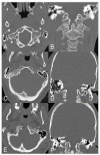Observational study of patients with occipital condyle fracture at a brazilian referral trauma center
- PMID: 34852040
- PMCID: PMC10683456
- DOI: 10.1590/0100-6991e-20213024
Observational study of patients with occipital condyle fracture at a brazilian referral trauma center
Abstract
Objective: to evaluate the clinical-epidemiological characteristics, treatment, and evolution of patients with occipital condyle fracture (OCF) at one of the largest referral trauma centers in Latin America.
Methods: this was a retrospective observational study of OCF identified from trauma cases admitted between December 2011 and December 2019 by the neurosurgery team at a Type 3 trauma center.
Results: a total of twenty-eight occipital condyle fractures were identified in twenty-six patients. The incidence was less than 0.2% per year and more common in male patients (4:1 ratio) involved in traffic accidents. The mean age was 42.08 years. Anderson and Montesano type II and Tuli type 1 were the most frequent (67.9% and 89.3%, respectively) and no case presented C0-C1-C2 instability. All patients were treated with a cervical collar for 3 to 6 months. About 65% of the patients exhibited good progression (Glasgow Outcome Scale equal to 4), and the severity of traumatic brain injury was the main determinant for negative outcomes.
Conclusion: the findings of this study are in accordance with available literature data. The use of external stabilization with a cervical collar is reinforced for the treatment of stable lesions, even when these are bilateral. Assessment of the patients' follow-up results in the studied sample may contribute with useful information for the treatment of occipital condyle fractures.
Objetivo:: avaliar o perfil clínico-epidemiológico, o tratamento e a evolução de pacientes com fraturas do côndilo occipital (FCO) em um dos maiores centros especializados em trauma na América Latina.
Método:: este é um estudo observacional retrospectivo de FCO identificadas em casos de trauma que foram atendidos no período de Dezembro de 2011 a Dezembro de 2019 pela equipe de trauma de centro de trauma Tipo 3.
Resultados:: um total de vinte e oito fraturas do côndilo occipital foram identificadas em 26 pacientes. A incidência foi inferior a 0.2% ao ano e mais comum em pacientes do sexo masculino (proporção 4:1) envolvidos em acidentes de trânsito. A idade média foi de 42.08 anos. O Tipo II de Anderson e Montesano e o Tipo 1 de Tuli foram os mais frequentes (67.9% e 89.3%, respectivamente) e nenhum caso teve instabilidades C0C1C2. Todos os pacientes foram tratados com colar cervical por período de 3 a 6 meses. Cerca de 65% dos pacientes apresentaram boa evolução (Escala de Resultados de Glasgow maior ou igual a 4), e a gravidade da lesão cerebral foi o principal determinante para os resultados negativos.
Conclusão:: os achados deste estudo são similares a dados disponíveis na literatura. O uso de colar cervical para estabilização externa é reforçado para o tratamento de lesões estáveis, mesmo quando bilaterais. A avaliação dos resultados do acompanhamento dos pacientes na amostra estudada pode contribuir com informações úteis para o tratamento de fraturas de côndilo occipital.
Conflict of interest statement
Conflict of interest: no.
Figures


Similar articles
-
Evaluation of using the Anderson-Montesano and the Tuli classifications in pediatric patients with occipital condyle fractures.J Orthop Surg Res. 2021 Jul 13;16(1):449. doi: 10.1186/s13018-021-02463-w. J Orthop Surg Res. 2021. PMID: 34256792 Free PMC article.
-
Occipital condyle fractures: incidence and clinical follow-up at a level 1 trauma centre.Emerg Radiol. 2009 Jul;16(4):291-7. doi: 10.1007/s10140-008-0789-z. Epub 2009 Feb 3. Emerg Radiol. 2009. PMID: 19189141
-
Occipital condyle fractures: clinical decision rule and surgical management.J Neurosurg Spine. 2009 Oct;11(4):388-95. doi: 10.3171/2009.5.SPINE08866. J Neurosurg Spine. 2009. PMID: 19929333
-
Occipital condyle fractures.Neurosurgery. 1997 Aug;41(2):368-76; discussion 376-7. doi: 10.1097/00006123-199708000-00006. Neurosurgery. 1997. PMID: 9257304 Review.
-
Traumatic occipital condyle fractures.Neurosurg Rev. 2000 Sep;23(3):161-4. doi: 10.1007/pl00011949. Neurosurg Rev. 2000. PMID: 11086742 Review.
Cited by
-
Occipital condyle fractures revisited.Emerg Radiol. 2024 Dec 5. doi: 10.1007/s10140-024-02303-4. Online ahead of print. Emerg Radiol. 2024. PMID: 39633150
References
-
- Bell C. Surgical observations. Middlesex Hospital Journal. 1817;4:469–470.
Publication types
MeSH terms
LinkOut - more resources
Full Text Sources
Medical
Miscellaneous

